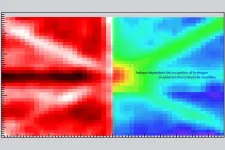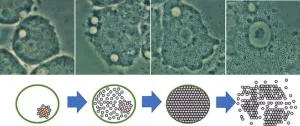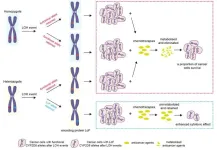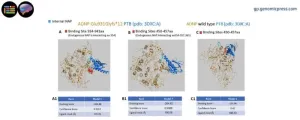(Press-News.org) Concreting mistakes can be expensive. Concrete poured too quickly often leads to a lack of colour uniformity, irregularities in the structure and uneven surfaces. Particularly in the case of exposed concrete, expensive reworking using concrete cosmetics is then necessary, sometimes a wall may even have to be demolished. In addition, if the fresh concrete rises too quickly in the formwork, there is a certain risk potential for the workers, as this can cause the formwork to break. In their DigiCoPro project, Ralph Stöckl and his brother Christoph Stöckl, together with Christian Hofstadler at the Institute of Construction Management and Economics at Graz University of Technology (TU Graz), have developed a prototype of a control system for concreting processes on construction sites that uses numerous sensors and sophisticated algorithms to prevent such errors and saves resources by eliminating the need for rework.
They were supported by a spin-off fellowship from the Austrian Research Promotion Agency (FFG). The establishment of a TU Graz spin-off, in which the patent-pending system will be brought to market maturity, is planned for 2025.
First test with parts from the internet
“Exposed concrete is the pinnacle of concreting and any mistake here can quickly become very expensive,” explains Ralph Stöckl. “It often happens that the concrete is poured too quickly and not compacted uniformly, meaning that the air cannot escape evenly from the concrete.” The former head of the Institute of Construction Management and Economics, Christian Hofstadler, drew Ralph Stöckl’s attention to this topic during his doctoral thesis and explained the need for a monitoring system designed for this purpose. Ralph Stöckl then discussed the issue with his brother and the two quickly agreed that they would like to develop such a system. They ordered the first sensors and other components online, produced a proof of concept and realised that they could measure the concrete’s climb rate. Together with Christian Hofstadler, they registered their development as a service invention and applied – successfully – to the FFG for a spin-off fellowship.
However, developing a finished prototype from the provisionally assembled concept that could revolutionise work with exposed concrete proved longer than they thought. After all, the monitoring system should measure and analyse dozens of other parameters in addition to the rate at which concrete climbs in order to provide a real-time warning if something goes wrong during concreting. The prototype now also measures humidity and the temperature of the air and the concrete surface, and records sound waves to determine when the vibrator is shaking air out of the concrete and when it is not. An algorithm works in the background, inferring from the data whether everything is in order or whether intervention is required.
Algorithms for harsh working environments
The built of the prototype and the development of the algorithm were done entirely in-house. The brothers brought electrical engineer Anja Elsässer on board for the construction, including all the necessary soldering work and circuit programming. Testing showed that the algorithm in particular had to be very carefully designed to ensure that interference factors, which inevitably occur in a harsh working environment such as a construction site, do not distort the measurement results. After 18 months of research work, the prototype has now been fully developed and the task now is to make it market-ready. In order to raise the necessary funds, Ralph and Christoph Stöckl will focus on a second mainstay after founding their spin-off at the beginning of 2025. They will use their expertise in AI and algorithms to develop service chatbots for companies.
“The work on DigiCoPro so far has been intensive and exciting. In addition to the spin-off fellowship from the FFG, we were also lucky to receive a lot of support internally at TU Graz, as entrepreneurial ambitions are very much encouraged here,” says Christoph Stöckl. “Now all we need to do is to obtain all the necessary certifications for our monitoring system so that we can officially offer it. We expect to be ready by 2026.”
END
A development by Graz University of Technology makes concreting more reliable, safer and more economical
With a digital monitoring system developed in-house, researchers at TU Graz want to help make costly and potentially dangerous mistakes in concrete work a thing of the past
2024-11-14
ELSE PRESS RELEASES FROM THIS DATE:
Pinpointing hydrogen isotopes in titanium hydride nanofilms
2024-11-14
Tokyo, Japan – Although it is the smallest and lightest atom, hydrogen can have a big impact by infiltrating other materials and affecting their properties, such as superconductivity and metal-insulator-transitions. Now, researchers from Japan have focused on finding an easy way to locate it in nanofilms.
In a study published recently in Nature Communications, researchers from the Institute of Industrial Science, The University of Tokyo have reported a method for determining the location of hydrogen in nanofilms.
Because they are very small, hydrogen atoms can easily migrate into the framework of other materials. Titanium absorbs hydrogen to give titanium hydrides, making ...
Political abuse on X is a global, widespread, and cross-partisan phenomenon, suggests new study
2024-11-14
A new study suggests that political abuse is a key feature of political communication on social media platform, ‘X’, and whether on the political left or right, it is just as common to see politically engaged users abusing their political opponents, to a similar degree, and with little room for moderates.
While previous research into such online abuse has typically focused on the USA, the current study found that abuse followed a common ally-enemy structure across the nine countries for which there was available data: Canada, France, Germany, Italy, Poland, Spain, Turkey, ...
Reintroduction of resistant frogs facilitates landscape-scale recovery in the presence of a lethal fungal disease
2024-11-14
(Santa Barbara, Calif.) — A remote lakeshore deep inside Yosemite National Park teems with life: coyotes, snakes, birds, tadpoles, frogs. The frogs are at the heart of this scene, which a decade ago was much different. It was quiet — and not in a good way. The frogs that are so central to this ecosystem were absent, extirpated by a deadly fungal disease known as amphibian chytrid fungus.
Now, thanks to the consistent and focused efforts of researchers and conservationists to save, then reintroduce, mountain yellow-legged frogs to this and numerous other lakes in Yosemite, their populations are again thriving.
A ...
Scientists compile library for evaluating exoplanet water
2024-11-14
ITHACA, N.Y. – By probing chemical processes observed in the Earth’s hot mantle, Cornell scientists have started developing a library of basalt-based spectral signatures that not only will help reveal the composition of planets outside of our solar system but could demonstrate evidence of water on those exoplanets.
“When the Earth’s mantle melts, it produces basalts,” said Esteban Gazel, professor of engineering. Basalt, a gray-black volcanic rock found throughout the solar system, are key recorders of geologic history, he said.
“When the Martian mantle melted, it also produced basalts. The moon is mostly basaltic,” he said. “We’re ...
Updated first aid guidelines enhance care for opioid overdose, bleeding, other emergencies
2024-11-14
Embargoed until 4 a.m. CT / 5 a.m. ET Thursday, November 14, 2024
DALLAS and WASHINGTON, Nov. 14, 2024 — The American Heart Association and the American Red Cross today released the “2024 Guidelines for First Aid,” which provide critical updates that equip first aid responders with the latest evidence-based practices to effectively respond to mild, moderate and life-threatening emergencies. The guidelines are published today in Circulation, the American Heart Association’s flagship journal.
“Providing first aid care is about recognizing that an emergency ...
Revolutionizing biology education: Scientists film ‘giant’ mimivirus in action
2024-11-14
The COVID-19 pandemic led to heightened public interest in learning about viruses and how they can cause diseases. There has been a lot of focus on communicating virology concepts to the general public in order to increase awareness about the spread and prevention of viral diseases.
When it comes to teaching biology, however, how do we explain microscopic processes like viral infections to students in the classroom?
In modern science education, seeing is believing—educators are now attempting to capture the attention of students by using eye-catching visuals and videos, instead ...
Genetic variation enhances cancer drug sensitivity
2024-11-14
By exploiting the genetic variation in cancer cells, an already approved cancer drug demonstrated enhanced effects against cancer cells in specific patient groups. This is shown in a recent study from Uppsala University, published in the journal eBiomedicine. The findings suggest a potential for more individually tailored and more effective cancer therapies.
The human genome is organised in 46 chromosomes, where all but the x and y chromosomes in men are present in two copies. This means that a person with a faulty gene on one chromosome most often has a functional version on the other. But during ...
Protective genetic mutation offers new hope for understanding autism and brain development
2024-11-14
Tel Aviv, Israel, 14 November 2024 – Tel Aviv University researchers have made a remarkable discovery that could revolutionize our understanding of genetic mutations and their role in brain development. The study, published today in Genomic Psychiatry, reveals that not all genetic mutations are harmful – some may actually offer protection against developmental disorders.
Led by Professor Illana Gozes, Director, The Elton Laboratory for Molecular Neuroendocrinology, the research team identified a protective inherited mutation in the Activity-Dependent Neuroprotective Protein (ADNP) gene. This finding challenges the traditional ...
Colombia's Dr. Natalia Acosta-Baena uncovers critical link between brain development and degeneration
2024-11-14
MEDELLÍN, Colombia, November 14, 2024 - In a breakthrough that bridges the gap between neurodevelopment and neurodegeneration, Dr. Natalia Acosta-Baena has identified a novel genetic syndrome that reshapes our understanding of brain disorders. Her research, featured in the latest Genomic Press Interview, reveals how a single gene involved in neuronal transport can influence both brain development and degeneration.
Dr. Acosta-Baena's discovery of a SPAG9 variant's role in both processes challenges the traditional view that neurodevelopmental disorders and neurodegeneration operate through distinct pathways. ...
How can we reduce adolescent pregnancies in low- and middle-income countries?
2024-11-14
Many young girls in low- and middle-income countries become pregnant early, which can be dangerous for them and for their babies. Studies show that girls who stay in school are less likely to get pregnant at a young age. Financial support can encourage girls to stay in school and delay pregnancy and marriage in some settings. However, a new large study from Zambia found that two years of financial support combined with comprehensive sexuality education and community dialogue meetings, moderately reduced ...
LAST 30 PRESS RELEASES:
What causes some people’s gut microbes to produce high alcohol levels?
Global study reveals widespread burning of plastic for heating and cooking
MIT study shows pills that communicate from the stomach could improve medication adherence
Searching for the centromere: diversity in pathways key for cell division
Behind nature’s blueprints
Researchers search for why some people’s gut microbes produce high alcohol levels
Researchers find promising new way to boost the immune response to cancer
Coffee as a staining agent substitute in electron microscopy
Revealing the diversity of olfactory receptors in hagfish and its implications for early vertebrate evolution
Development of an ultrasonic sensor capable of cuffless, non-invasive blood pressure measurement
Longer treatment with medications for opioid use disorder is associated with greater probability of survival
Strategy over morality can help conservation campaigns reduce ivory demand, research shows
Rising temperatures reshape microbial carbon cycling during animal carcass decomposition in water
Achieving ultra-low-power explosive jumps via locust bio-hybrid muscle actuators
Plant-derived phenolic acids revive the power of tetracycline against drug-resistant bacteria
Cooperation: A costly affair in bacterial social behaviour?
Viruses in wastewater: Silent drivers of pollution removal and antibiotic resistance
Sub-iethal water disinfection may accelerate the spread of antibiotic resistance
Three in four new Australian moms struggle with body image
Post-stroke injection protects the brain in preclinical study
Cardiovascular risk score predicts multiple eye diseases
Health: estimated one in ten British adults used or interested in GLP-1 medications for weight loss
Exercise to treat depression yields similar results to therapy
Whooping cough vaccination for pregnant women strengthens babies’ immune system
Dramatic decline in new cases of orphanhood in Uganda driven by HIV treatment and prevention programs
Stopping weight loss drugs linked to weight regain and reversal of heart health markers
Higher intake of food preservatives linked to increased cancer risk
Mass General Brigham–developed cholera vaccine completes phase 1 trial
First experimental validation of a “150-year-old chemical common sense” direct visualization of the molecular structural changes in the ultrafast anthracene [4+4] photocycloaddition reaction
Lack of support for people on weight loss drugs leaves them vulnerable to nutritional deficiencies, say experts
[Press-News.org] A development by Graz University of Technology makes concreting more reliable, safer and more economicalWith a digital monitoring system developed in-house, researchers at TU Graz want to help make costly and potentially dangerous mistakes in concrete work a thing of the past







